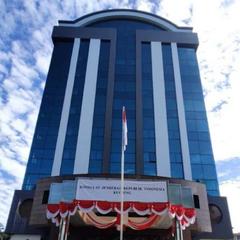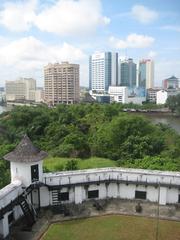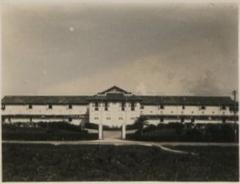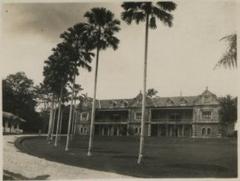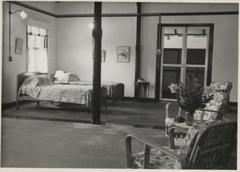Ching San Yen Temple Visiting Hours, Tickets, and Kuching Historical Sites Guide
Date: 04/07/2025
Introduction
Perched atop a verdant hill overlooking the Sarawak River estuary in Kuching, Malaysia, Ching San Yen Temple (青山岩庙) is an enduring symbol of Kuching’s Chinese heritage and multicultural harmony. Established between 1848 and 1864 by pioneering Hokkien and Teochew settlers, this historic temple has served as a spiritual sanctuary, navigational landmark, and community hub for generations (Sarawak Tourism Board; Borneo Post). Today, it remains a must-visit destination for travelers interested in history, culture, and panoramic views of the Sarawak River delta.
This comprehensive guide explores the temple’s origins, architectural heritage, religious significance, major festivals, visiting information, and its role in fostering Kuching’s unique spirit of community and intercultural understanding.
Table of Contents
- Origins and Early Development
- Architectural Heritage and Restoration
- Heritage Status and Recognition
- Historical Significance in Migration and Settlement
- Religious and Cultural Symbolism
- Visiting Hours, Tickets, and Travel Tips
- Major Festivals and Annual Events
- Community Harmony and Cultural Activities
- Visitor Experience: Facilities and Accessibility
- Nearby Attractions and Travel Tips
- Preservation Efforts
- Frequently Asked Questions (FAQ)
- Visuals and Media
- Plan Your Visit Today
- Summary and Key Visitor Tips
- References
Origins and Early Development
Ching San Yen Temple’s roots trace back to the mid-19th century, when Chinese settlers—primarily from the Hokkien and Teochew communities—founded it as a place of refuge and worship. The temple, whose name means “Green Hill Pavilion,” was strategically built atop a hill to serve both spiritual and practical purposes: providing solace to new arrivals and acting as a landmark for navigators sailing into Borneo (Sarawak Tourism Board; Borneo Post). According to oral history, its establishment was a gesture of gratitude for safe sea crossings and divine protection.
A natural well at the hill’s base, said to be discovered via divine guidance, supplied fresh water to local villagers until the 1980s, further cementing the temple’s role as both a spiritual and practical community center (etawau.com).
Architectural Heritage and Restoration
Ching San Yen Temple is a prime example of Southern Chinese temple architecture. Key features include:
- Sweeping tiled roofs with upturned eaves and decorative ridge ornaments.
- Intricate wood carvings depicting dragons, phoenixes, and auspicious symbols.
- Bright red and gold color schemes symbolizing prosperity and good fortune.
- Courtyards and pavilions arranged to follow feng shui principles (Kuching In Focus).
Major renovations in 1903, the late 1990s, and early 2000s have preserved these features. Additions such as a vegetarian dining hall, landscaped gardens, and the “Footprint of Lord Buddha” (a symbolic stone carving with 108 auspicious motifs) reflect evolving community needs and artistic traditions (kuchingborneo.info).
Heritage Status and Recognition
Though not a UNESCO World Heritage Site, Ching San Yen Temple is safeguarded under local heritage laws and widely recognized as a key cultural landmark in Sarawak (Sarawak Heritage Society). It plays a central role in annual religious and cultural celebrations, drawing visitors from across Malaysia and beyond.
Historical Significance in Migration and Settlement
Beyond its spiritual functions, the temple served as a gathering place for early settlers, offering support networks, mediation in disputes, and documentation of immigrant lineages. Temple archives, some over 150 years old, provide valuable insight into Sarawak’s Chinese diaspora and migration history (New Straits Times).
Religious and Cultural Symbolism
Ching San Yen Temple reflects the syncretic traditions of Malaysia’s Chinese community, blending Taoism, Buddhism, and local folk practices. Its main altars honor:
- Goddess of Mercy (Guanyin)
- Heavenly Queen (Mazu, Goddess of the Sea)
- Lord Buddha, Amitabha, and Buddha of Medicine
- Other deities: Tua Pek Kong, Lao Tze, Deities of Sun and Moon, and more (etawau.com).
Rituals—including incense offerings, vegetarian communal meals, and festive ceremonies—underscore the temple’s role as a hub for religious observance and community charity (malaysianow.com).
Visiting Hours, Tickets, and Travel Tips
- Hours: Open daily, 8:00 AM to 6:00 PM.
- Admission: Free (donations appreciated).
- Location: Kampung Muara Tebas, about 27 km or a 30–40 minute drive from Kuching Waterfront (Malaysia Traveller).
- Access: By car/taxi (parking RM5 per vehicle, collected by local villagers). Limited public transportation.
- Stairs: Approximately 100 steps; rest platforms and handrails provided.
- Accessibility: Wheelchair access is limited due to the hilltop setting, but assistance may be available upon arrangement.
- Facilities: Restrooms, shaded seating, gift shop, vegetarian dining hall.
- Dress Code: Modest attire recommended.
Tips: Visit early morning or late afternoon for cooler weather and optimal photography. Combine your visit with nearby attractions or a seafood meal at local restaurants.
Major Festivals and Annual Events
Chinese New Year
The temple is especially lively during Chinese New Year, when over 250,000 devotees visit for prayers, incense offerings, and blessings (The Borneo Post). The temple is adorned with lanterns, and the air fills with the scent of joss sticks and the sounds of traditional rituals.
Mid-Autumn Festival
Celebrated with mooncakes, lantern processions, and cultural performances, the Mid-Autumn Festival draws local families and tourists alike (Trek Zone).
Other Observances
Throughout the year, the temple hosts Buddhist, Taoist, and folk ceremonies, including deity birthdays and Buddhist holy days. Communal vegetarian meals and open-house events foster inclusivity (Malaysia Traveller).
Community Harmony and Cultural Activities
Ching San Yen Temple stands as a testament to Kuching’s model of religious tolerance. Located in a predominantly Malay fishing village, its festivals and daily life are marked by cooperation between Chinese and Malay residents. Notably, Malay villagers have long volunteered in the temple kitchen during festivals, serving vegetarian meals to all (malaysianow.com; etawau.com).
The temple also hosts calligraphy workshops, cultural performances, and storytelling sessions about Chinese folklore and the temple’s deities (Trek Zone).
Visitor Experience: Facilities and Accessibility
- Atmosphere: Panoramic views of the Sarawak River, South China Sea, and mangrove forests from the 2.5-acre hilltop site.
- Architectural highlights: Traditional paifang (gateway), guardian lion statues, main hall with ornate altar, and the “Footprint of Lord Buddha.”
- Rest areas: Shaded benches along the ascent and within temple grounds.
- Dining: Vegetarian meals are served during major festivals, reflecting the temple’s charitable ethos.
- Photography: Permitted in outdoor and courtyard areas; please be discreet during ceremonies and seek permission for indoor shots.
Nearby Attractions and Travel Tips
Combine your visit to Ching San Yen Temple with other Kuching historical sites:
- Kuching Waterfront: Scenic promenade along the Sarawak River.
- Sarawak State Museum: Comprehensive exhibits on local history.
- Old Courthouse: Colonial architecture and cultural events.
- Kampung Muara Tebas: Experience local village life and savor fresh seafood (Malaysia Traveller).
Seasonal Note: Consider planning your visit during the Kuching Festival Food Fair (July–August), a major citywide celebration (Sarawak Tribune).
Preservation Efforts
The temple’s preservation is an ongoing community effort, with recent restorations funded by donations and government grants. Local elders, volunteers, and the Kuching Hokkien Association focus on maintaining the temple’s structural integrity while educating visitors about its history (Sarawak Heritage Society; Borneo Post).
Frequently Asked Questions (FAQ)
What are the visiting hours of Ching San Yen Temple?
Open daily from 8:00 AM to 6:00 PM.
Is there an entrance fee?
No, entrance is free. Donations are appreciated.
Are guided tours available?
Yes, especially during festivals or by arrangement with temple management.
Is the temple accessible for people with disabilities?
Access is limited due to stairs; assistance may be available.
When is the best time to visit?
During major festivals (Chinese New Year, Mid-Autumn Festival) for cultural immersion, or anytime for a tranquil experience.
Visuals and Media
- Exterior view of the temple with the Sarawak River in the background.
- Main altar with Buddhist and Taoist deities.
- Festival celebrations and communal meals.
- Detailed shots of roof ornaments and carvings.
For images and virtual tours, visit the Sarawak Tourism Board and TripAdvisor.
Plan Your Visit Today!
Download the Audiala app for up-to-date schedules, festival information, and guided tour bookings. Follow us on social media for more tips on Kuching’s cultural sites. Begin your journey at Ching San Yen Temple and experience the best of Sarawak’s spiritual and multicultural heritage.
Summary and Key Visitor Tips
Ching San Yen Temple is a living testament to Kuching’s rich Chinese heritage, blending historical significance, Southern Chinese architecture, and vibrant cultural traditions. Its panoramic hilltop views, well-maintained artifacts, and major festivals offer visitors a unique window into Sarawak’s multicultural identity. The temple’s welcoming atmosphere and community-driven initiatives, such as vegetarian meals and interfaith collaboration, make it a beacon of religious harmony and social cohesion (Sarawak Tourism Board; Borneo Post). Free daily access, guided tours during festivals, and proximity to other attractions ensure a rewarding and accessible visitor experience (Trek Zone; Malaysia Traveller; etawau.com). Download the Audiala app to enhance your visit and deepen your appreciation of this extraordinary heritage site.
References
- Sarawak Tourism Board
- Borneo Post
- Sarawak Heritage Society
- etawau.com
- Malaysianow
- Kuching Borneo Info
- The Borneo Post
- Kuching In Focus
- Borneo Post - 2013
- Sarawak Tribune
- Malaysia Traveller
- Trek Zone
- New Straits Times
- TripAdvisor
